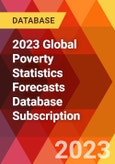The 2023 Global Poverty Statistics database is an online subscription service featuring the most accurate and current outlooks on 30 economic statistics for the largest 100 countries. These Poverty Statistics include Income share held by highest 10%,
Income share held by highest 20%, Income share held by lowest 10%, Income share held by lowest 20%, Income share held by second 20% (as well as many others).
The subscription databases provide economic, social, and industry size data for a three-year historical trend (2017-2020), a four-year forecast estimate trends (2021-2024) for 100+ countries.
Economic and social statistics forecasts include weights based on GDP changes, population changes, inflation changes, and labor changes. Industry and product shipments include the total value of all products produced and shipped by all producers (also described as value of receipts, value of production, or value of work done.) Manufactured products include only products made within each country (not imports resold as exports). Consumer products include brick and mortar retail sales, as well as online retail sales within each country.
The data are calculated with extensive economic models that use the most recent historical data from government statistical bureaus and trade associations to develop projections in economic, social, and industry databases. These economic models are unique because they use both longitudinal (horizontal) and latitudinal (vertical) analysis for its forecasts. The longitudinal analysis uses regression analysis to generate projections based on historical data. The latitudinal analysis examines the growth changes in one economic, social, or industry statistic based on other related statistics (for example, would an increase in the global electric vehicle manufacturing industry cause a decrease in the traditional automobile manufacturing industry? Or would an decrease in U.S. exports cause increase in Chinese exports?)
The database subscriptions are essential for financial experts (investment banking, mutual funds, brokers), industry executives (for budgeting and economic projections), market researchers (for market sizing and market growth rates), and educational researchers (business libraries and their professors and students for their research studies).
Income share held by highest 20%, Income share held by lowest 10%, Income share held by lowest 20%, Income share held by second 20% (as well as many others).
The subscription databases provide economic, social, and industry size data for a three-year historical trend (2017-2020), a four-year forecast estimate trends (2021-2024) for 100+ countries.
Economic and social statistics forecasts include weights based on GDP changes, population changes, inflation changes, and labor changes. Industry and product shipments include the total value of all products produced and shipped by all producers (also described as value of receipts, value of production, or value of work done.) Manufactured products include only products made within each country (not imports resold as exports). Consumer products include brick and mortar retail sales, as well as online retail sales within each country.
The data are calculated with extensive economic models that use the most recent historical data from government statistical bureaus and trade associations to develop projections in economic, social, and industry databases. These economic models are unique because they use both longitudinal (horizontal) and latitudinal (vertical) analysis for its forecasts. The longitudinal analysis uses regression analysis to generate projections based on historical data. The latitudinal analysis examines the growth changes in one economic, social, or industry statistic based on other related statistics (for example, would an increase in the global electric vehicle manufacturing industry cause a decrease in the traditional automobile manufacturing industry? Or would an decrease in U.S. exports cause increase in Chinese exports?)
The database subscriptions are essential for financial experts (investment banking, mutual funds, brokers), industry executives (for budgeting and economic projections), market researchers (for market sizing and market growth rates), and educational researchers (business libraries and their professors and students for their research studies).
Table of Contents
- Income share held by fourth 20%
- Income share held by highest 10%
- Income share held by highest 20%
- Income share held by lowest 10%
- Income share held by lowest 20%
- Income share held by second 20%
- Income share held by third 20%
Countries Covered
- Argentina
- Australia
- Austria
- Belgium
- Bolivia
- Brazil
- Canada
- Chile
- China
- Colombia
- Denmark
- Egypt
- Finland
- France
- Germany
- Greece
- Greenland
- Guam
- Hong Kong Sar, China
- Iceland
- India
- Israel
- Italy
- Japan
- Korea, Rep.
- Lithuania
- Mexico
- Norway
- Pakistan
- Panama
- Poland
- Portugal
- Puerto Rico
- Qatar
- Russia
- Romania
- Saudi Arabia
- Singapore
- Slovak Republic
- Slovenia
- South Africa
- Spain
- Sweden
- Switzerland
- Turkey
- United Arab Emirates
- United Kingdom
- United States
- Venezuela
- Vietnam
- Virgin Islands (U.S.)
Methodology

LOADING...








